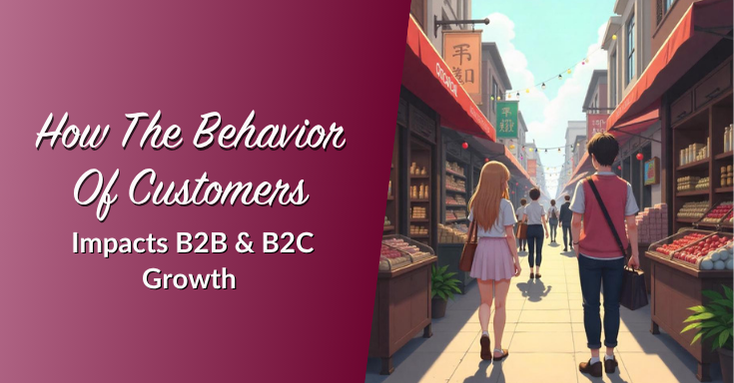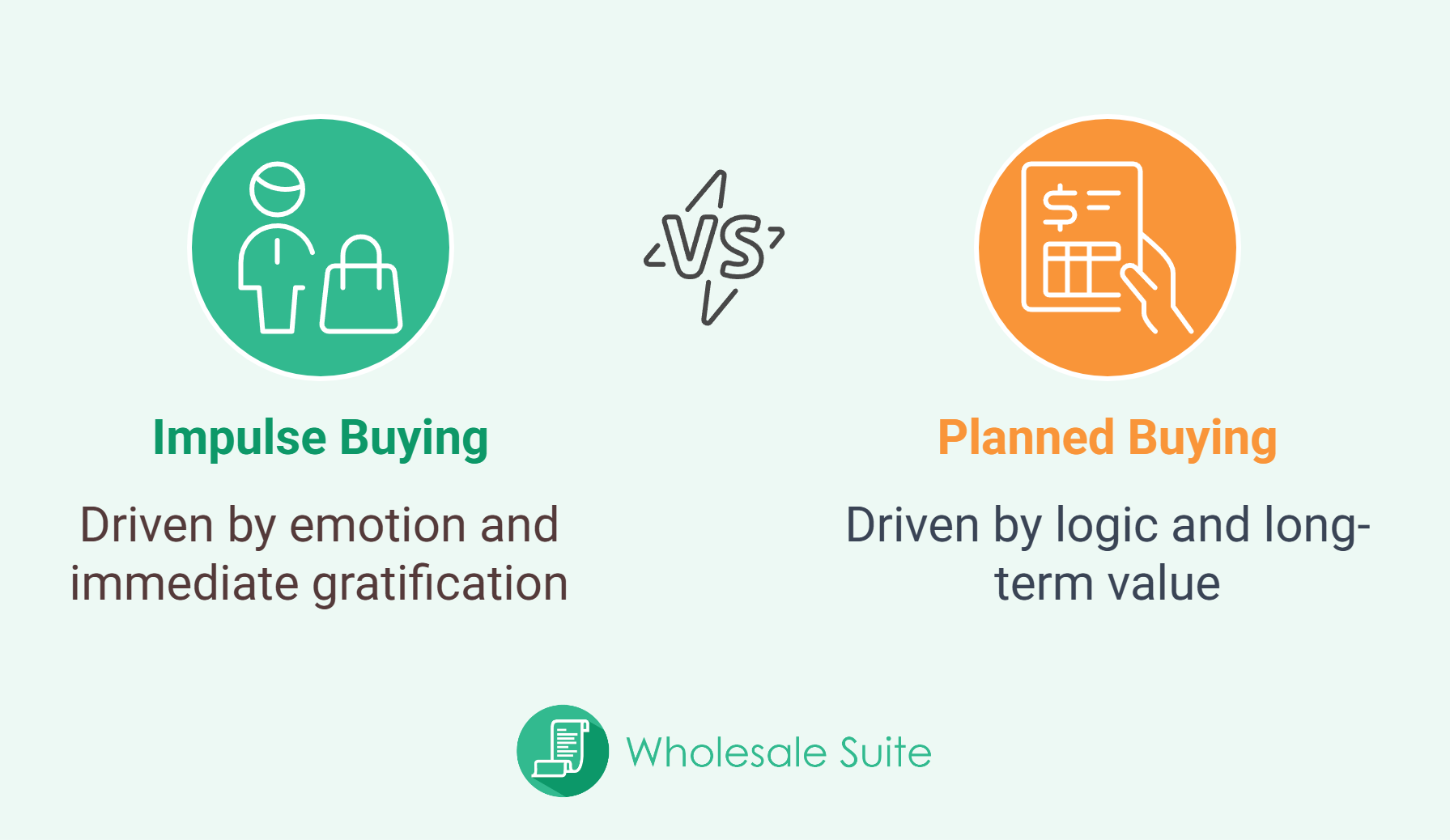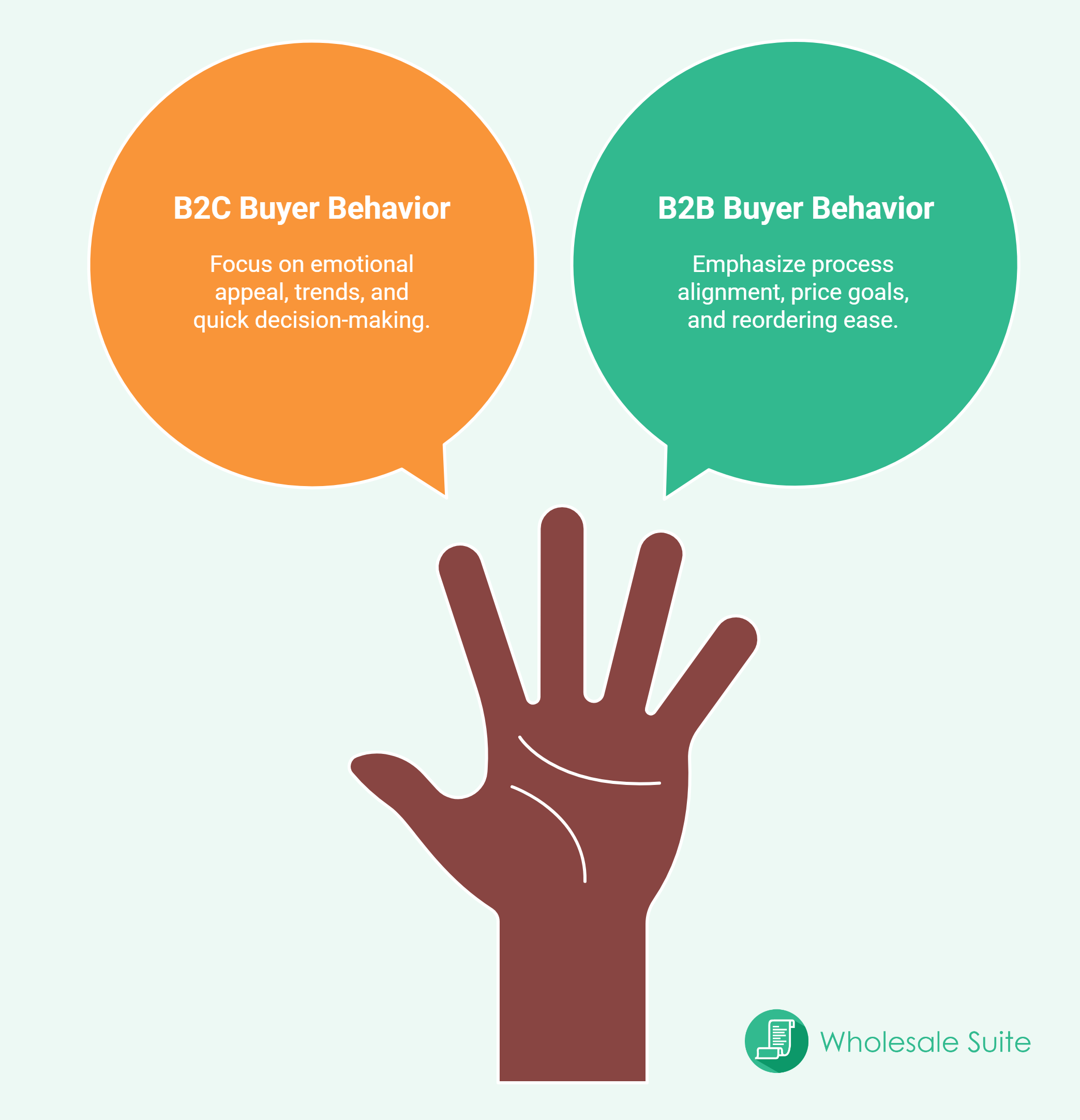
The behavior of customers shapes everything in your business. Whether you sell to shoppers or other businesses, every choice your buyers make comes from something more profound. Some take their time. Others buy right away. Some ask questions. Others rely on reviews or price. These actions are not random. Each of these actions shows what matters to them. Whether you sell to businesses or regular shoppers, this behavior is the key that connects you to what they really want.
What Is Consumer Behavior?
The concept of consumer behavior
The concept of consumer behavior is about how people act before, during, and after they buy something. It examines how customers think, feel, and make decisions. In B2C, it encompasses aspects such as personal needs, habits, and emotions. In B2B, it also involves long-term planning and company goals.
For example, a business buyer may not make a decision alone. They might need approval from a manager. That means their decision is slower and based on different reasons than a regular shopper. By conducting customer behavior analysis, businesses can gain insight into what motivates their audience. This helps shape more effective messages, offers, and timing.
Why customer behavior matters in retail and wholesale
In retail, customer behavior shows up in small ways. A customer might leave the store if there is no sale. Or they may buy more if the product has good reviews. In wholesale, it works differently. Buyers are concerned with supply, price breaks, and delivery times.
If you study consumer behavior across both types of stores, you will find that it helps you make smarter decisions. You can prepare stock more effectively, plan your pricing, and avoid mistakes by analyzing past patterns.
How does it affect purchase decisions?
The behavior patterns of your customers directly affect your sales. When you understand what they care about, you can guide them more effectively.
In B2B, many buyers undergo a complex buying process. They compare prices, look at shipping speed, and check reliability. Their past behaviour shapes each step in their consumer buying process.
If you want to grow your B2B or B2C business, you must prioritise customer experience. Listen to what your buyers do, not just what they say.
Types Of Customer Behavior
Not all customers think or act in the same way. These habits are part of the behavior of customers, and they play a big role in how businesses grow. By understanding the types of consumer behavior, you can begin to recognize these patterns. Let’s review them one by one and discuss each.
Impulse buying vs. planned buying
There are two common ways people shop. One is called impulse buying. These buyers are often drawn in by limited-time deals, catchy photos, or something they find exciting. According to Invesp Statistics and Trends 2025, 40% of all the money spent on e-commerce is attributed to impulse purchases. This type of buying behavior is very common in retail. One second, they were browsing; the next, they were at checkout.
On the other hand, planned buying happens when the customer takes their time. They think first, compare prices, and look at reviews. They might even wait for a better offer. This happens a lot in wholesale. B2B buyers do not usually rush. They need to buy in bulk, so every purchase has to make sense for their business.
If you understand the type of customer behavior that fits your audience, you can design your store to help them make better purchases. And when your store matches the behavior of customers, it becomes easier to turn views into sales.
B2B buyer behavior vs. B2C customer behavior
B2B and B2C customers act very differently. A B2C customer shops for personal use, and they care about emotions, trends, and price. A good photo or a nice product review can help them decide right away. Their consumer buying habits are often quick and driven by emotion.
B2B buyers think differently. They are often buying on behalf of a team or company. Their behavior patterns include verifying that the product aligns with their process, meets their price goals, and arrives on time. They also look at how easy it is to reorder.
The 10 Different Behaviours Of Retail & Wholesale Customers
1. Sales discount strategies aren’t as effective on wholesale customers
One of the core marketing strategies many stores use these days to attract retail customers is to run almost perpetual sales and discounts.
Unfortunately, this doesn’t garner as much attention for wholesale customers, even if they are motivated more by permanent bulk discounts and other non-sale-related tactics, such as invoice payment over instant payment.
2. Wholesale customers are driven by their customers
A wholesale customer’s ordering patterns are mostly driven by what their customers are buying. On the other hand, a retail customer’s purchasing decisions can be influenced by marketing and sales tactics.
3. Accounts vs upfront payment
A major attraction for wholesale customers is the ability to pay via invoice. A retail customer is forced to pay via credit card, cash or other upfront payment options such as PayPal.
The ability to offer a 30-, 60-, or 90-day term on an invoice, rather than paying upfront, will attract many wholesale customers. They can then purchase stock with no money down and have 30-90 days or more to sell it to their customers in order to pay their bill.
4. Repeat orders are easier to encourage with wholesale customers
With the exception of a recurring sales model, such as a subscription-based business, wholesale customers are generally easier to encourage to place repeat orders.
There are many strategies you can use to encourage repeat orders and increase the overall frequency of their ordering.
5. Wholesale customers need more support
Overall, wholesale customers will need more support than your retail customers.
This perspective encompasses sales support, sales literature, physical product displays (often given away to stores), ordering sheets, FAQs, order management, and more.
Retail orders, once fulfilled, will rarely require further intervention unless there is an issue with the product.
6. Margins are usually tighter, so terms of sale make a big difference
Everyone along the fulfillment chain needs to make their money. Therefore, the margin on wholesale orders is usually significantly less than that on retail orders.
What makes up for it is the bulk nature of wholesale orders, where you can afford to offer a price break in exchange for receiving much larger orders.
That’s why the terms of sale (minimum order subtotals, quantity amounts, etc.) tend to play a significant role in arrangements with wholesale customers.
7. Wholesale customers have customers to please
We touched on this lightly before; by nature of the business, wholesale customers have their own customers to please and thus are more driven by their customers’ needs than your need to shift certain products.
Sales encouraging them to order certain products rarely make a huge difference to their ordering preferences. As an alternative strategy, you can help them sell more of certain products by providing better front-end sales support.
8. Retail customers are choosy; wholesale customers are not
Part of being a retail customer is the ability to pick and choose. In a retail store setting, someone might choose not to buy an item based on something trivial. It may be because of the look of it, or if it has a mark they don’t like. This is because they’re buying ones and twos of items.
A wholesale customer, when they place an order, will typically do so based on large quantities. They don’t necessarily get to choose what they have to order. This is because their opinion doesn’t really come into the equation.
9. Wholesale customers are easily divided into tiers
Retail customers are difficult to categorise into distinct groups beyond marketing segments. Wholesale customers, on the other hand, can be easily divided into tiers based on their ordering behaviour.
Shop owners often do this based on the amount their wholesale customer is ordering. They will also sign them up for a minimum ordering volume with a tiered pricing rate.
10. Attracted to different aspects of an offer
Finally, retail customers are more attracted to the appearance of an offer. It might be the look of an item, what kind of discount they can get or the reputation of a brand.
Wholesale customers are more attracted to the terms of the offer, such as the minimum ordering requirements, price breaks for wholesale orders, and the payment terms (invoice terms).
Key Factors That Influence The Behavior Of Customers
The behavior of customers does not happen by accident. Many different things shape it. Some of these habits stem from personal choices. Others are based on the store experience itself. When you understand how your customers think and act, it becomes easier to guide them. These key factors can help you understand both the emotional and practical side of consumer behavior.
1. Pricing, product quality, and availability
Price is one of the first things buyers notice. In B2C, even slight price changes can have a significant impact on sales. In B2B, bulk pricing and volume discounts shape buying behavior. Product quality also matters. If customers get items that break or fail easily, they lose trust. And when something is always out of stock, they may not return and look for other alternatives. Availability shows whether they can count on you. Together, these three factors influence how people behave and whether they return.
2. Social proof and brand reputation
Customers often read reviews before making a purchase. If others had a good experience, new buyers are more likely to trust your store. In B2B, a strong brand or a history of success with other clients builds confidence. These signs of trust are part of how consumer behavior works. Simply put, people want to feel safe before they pay.
3. User experience and customer service
If your website is slow or confusing, people may not buy from you. This is an integral part of the customer experience. Clear buttons, working filters, and fast checkout make buying easier. In wholesale, good customer service also matters. Buyers may have special requests. When they feel heard, they stay. These things may seem small, but they shape the behavior of customers in big ways.
💡Tip: A plugin like Wholesale Order Form enables buyers to place bulk orders quickly without needing to switch between pages. It’s fast, simple, and made for wholesale buyers who value speed and clarity. This type of setup enhances how people interact with your store and fosters more positive customer behaviour over time.
4. Emotions and personal values
Some buyers care deeply about how a product makes them feel. For example, someone might support a local brand or choose eco-friendly items. Emotions drive many parts of consumer buying. In both retail and wholesale, values can affect what people support and why they return.
5. Seasonality and timing
The time of year affects how people shop. Retail buyers may spend more during holidays. Wholesale buyers may plan ahead before peak seasons. If you observe these shifts, you can adjust your store accordingly. Timing also affects complex buying decisions in B2B, such as when budgets are approved or inventory is required.
You may also read about “Get More For Less: Seasonal Discounts You Need To Know.”

6. Store policies and return guarantees
Buyers feel safer when they know they can return something. A clear return policy removes fear. This builds trust and shapes consumer behavior in both retail and wholesale by making people feel more confident and secure.
7. Payment options and flexibility
When buyers see payment methods they trust, they feel safer. Some prefer paying later or in installments. Others want a credit card or a bank transfer. Offering multiple payment options helps reach a wider audience and supports more effective consumer behavior outcomes.
💡Tip: With Wholesale Payments, you can offer flexible payment terms that fit how wholesale buyers prefer to pay. This enhances trust and reduces friction, which can result in smoother transactions and more positive customer behavior in the long run.
8. Shipping costs and delivery speed
If shipping is too slow or too expensive, customers may leave. In B2B, timing affects inventory planning. In B2C, it affects convenience. Shipping is often overlooked as part of the customer experience that many forget to improve.
9. Loyalty programs and buyer incentives
Giving something extra can shape the behavior of customers over time. Points, discounts, or early access can make people return. In wholesale, this can include special pricing or extra stock. These small things reward loyal behavior.
💡Tip: Tools like Advanced Coupons work great with WooCommerce. You can create smart deals like buy-one-get-one offers, coupon scheduling, or loyalty rewards (all without needing to code!). These types of rewards encourage repeat purchases and improve customer behavior by giving buyers a reason to return.
10. Mobile vs. desktop shopping behavior
Some people shop on their phones. Others prefer computers. Watching how your customers act on each helps you fix problems. Maybe your mobile site is slow. Or maybe checkout works better on a desktop. This is part of daily customer behavior analysis that you would also have to consider.
You may also read about: How To Make Your Website Mobile-Friendly (5 Tips For Wholesalers).

Analyzing Customer Behavior
You cannot improve what you cannot see. That’s why tracking the behavior of customers is one of the smartest things you can do, whether you’re in retail or wholesale.
1. Analytics for ecommerce stores
Most ecommerce platforms offer basic analytics that track the behavior of customers. You can see which products are most popular, where buyers drop off, and which pages lead to the most checkouts. These details show you the truth about customer behavior in real-time.
Tracking how users interact with your site helps you adjust your layout, pricing, and product listings based on actual consumer behavior, rather than just guesses.
2. Customer journey mapping
This tool illustrates how buyers progress from one step to the next. It helps you understand the full path of a buyer, from visiting your homepage to clicking on a product to checking out. When you map out the behavior of customers, you identify areas where they stop, become confused, or lose interest.
Once you know what slows them down, you can address the issue. A better flow leads to better results. Even small changes based on buyer actions can lead to higher sales.
3. Using surveys and reviews
Sometimes, the best way to understand the behavior of customers is to hear from them directly. After a purchase, ask quick questions: What made them buy? What almost stopped them? These answers help support your data and reveal things numbers alone cannot.
Combining surveys, reviews, and analytics gives you a full view of the behavior of customers. With that knowledge, you can build a store that fits how real people shop, not how you think they shop.
Frequently Asked Questions
What are the 5 main factors that influence consumer behavior?
There are five primary factors that influence consumer behavior. First is personal needs. People buy based on what they need or want at that moment. Next is social influence, which encompasses friends, family, and even online trends. Then there’s cultural background. Where a person comes from can affect how they view a product or brand. The fourth factor is buying power, which refers to the amount of money someone can spend. A person’s budget always affects how they shop.
Lastly, there is customer experience. If a customer had a good or bad experience shopping in the past, it will influence how they behave the next time. All of these work together to shape the full behavior of customers. This is why it helps to watch what customers do, not just what they say.
How to measure customer behaviour?
There are many simple ways to measure the behavior of customers. One is through analytics, which show what pages people visit, how long they stay, and where they drop off. Another tool is heatmaps, which help you see where customers click, scroll, or stop on your site.
Surveys and reviews are also helpful because they provide honest feedback about what led someone to make a purchase or why they left. You can also review purchase history, which reveals patterns in consumer buying habits and helps you understand what people like and how often they return.
What is consumer search behavior?
Consumer search behavior is how buyers look for what they want. It includes the words they type into search bars, the filters they use, and the way they compare different products. This kind of customer behavior shows what matters most to your buyers: price, style, brand, or something else.
Final Thoughts
After working with store owners and observing how they grow, one thing always stands out: those who pay attention to customer behavior grow faster. It’s not just about having good products or a visually appealing website. It’s about understanding what buyers actually do, what motivates them to click, pause, or make a purchase.
Let’s do a recap on the things we discussed about consumer behavior:
- What is consumer behavior
- Types of customer behavior
- 10 different behaviors of retail & wholesale
- Behavior of customers (key factors)
- Analyzing customer behavior
The behavior of customers is constantly changing. What worked last year might not work now. However, if you continue to observe the patterns, listen to feedback, and make adjustments along the way, you’ll stay ahead. Whether it’s retail or wholesale, growth comes from understanding your buyers better than anyone else and building your store around the way they think, search, and decide.
Every action your customers take is a signal. And those signals lead to better decisions when you know how to read them. 💚






